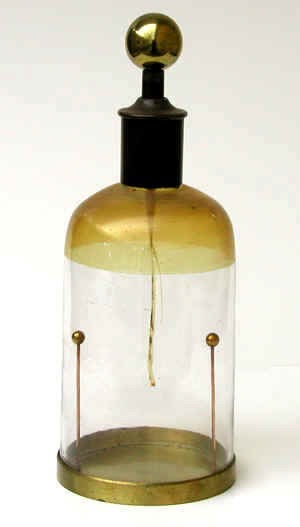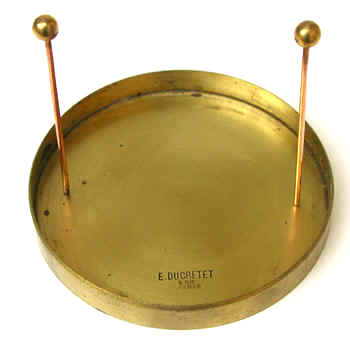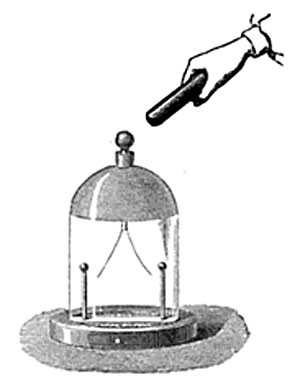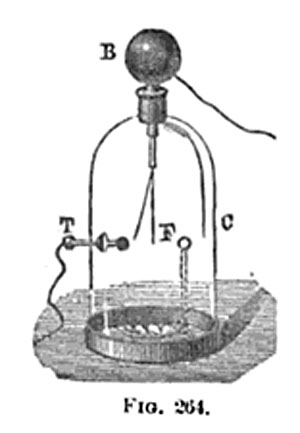Bennet Gold-Leaf Electroscope (ca. 1880s)

This is a gold leaf electroscope for qualitative demonstrations of electrostatic phenomena. It was manufactured by E. Ducretet of Paris, the famous French manufacturer of scientific instruments. This design is essentially the same as the first gold leaf electroscope built by Abraham Bennet in the 1700s, and for this reason it is sometimes referred to as a Bennet-type electroscope.
The body is glass. The circular base, the vertical support rod, and the metal sphere connected to the top of the rod are brass. Two gold leaves are suspended from the bottom end of the rod. One leaf is about half the length of the other. The result is that the shorter of the two leaves is deflected to a much greater extent than the longer one when the electroscope is charged. It might well have been this type of observation that led to the design of the single leaf electroscopes that substitute a fixed vertical rod for one of the leaves.
The gold-colored coating on the top portion of the glass is either lacquer or shellac. Its purpose was to prevent atmospheric moisture from depositing on the glass in the vicinity of the rod from which the leaves were suspended. Moisture, if it were present, could result in a leakage current over the glass that would rob the gold leaves of their charge.
This is explained nicely by Ganot and Reinhold: "The object of this coating is to improve the insulating qualities of the glass. Glass is, indeed, a bad conductor, but it is very hygroscopic—that is, it readily attracts aqueous vapor from the air, and thus becomes coated with a layer of moisture, which renders its surface a conductor. When covered with varnish this evil is removed, for varnish,... is not hygroscopic."
It is common for glass-body electroscopes to incorporate two conductors, one on each side of the leaves, that extend vertically from the base plate. These conductors might be two metal foil "earthing" strips like those seen in the Volta-type condensing electroscope, or two brass rods ending in spherical knobs like those in this electroscope (see photo below left). You never find both types together in the same electroscope, which indicates that they had a shared purpose.

Several functions have been attributed to these things.
First (my thought), they may have served a similar role as the two earthing (screening) strips that are often employed in gold leaf electroscopes, i.e., to protect the leaves from static charges that can accumulate on the glass and other external electric fields.
Another explanation was offered by Adolphe Ganot, author of what was probably the most widely used physics textbook of the nineteenth century: "the delicacy of this electroscope may be increased by adapting to the foot of the apparatus two metal rods, terminating in knobs; for these knobs, being excited by induction from the gold leaves, react upon them."

Finally, the explanation of Augustin Privat-Deschanel: "Great caution must be used in bringing electrified bodies near the gold-leaf electroscope, as the leaves are very apt to be ruptured by quick movements. If they diverge so widely as to touch the sides of the bell-glass, it is often difficult to detach them from the glass without tearing. To prevent this contact, two metallic columns are interposed, communicating with the ground. If the leaves diverge too widely, they touch these columns and lose their electricity."
The drawing to the right is from Privat-Deschanel (1878).
They also provided a crude way to estimate the total charge on the body used to charge the gold leaves. The following quote from Daniell explains how this works: "In the discharging electroscope the gold leaves when they diverge, come in contact with two metallic uprights which communicate with the earth: they are thus discharged and collapse, again to be charged: the number of oscillations of the gold leaves affords a rough measure of the quantity of electricity borne by a conductor which is discharged to earth through such an electroscope.

As seen in the accompanying diagram (Barker, 1892), only one "metallic upright" was needed.
Quoting Barker: "For the transfer of smaller quantities, Gaugain has used a discharging gold-leaf electroscope in much the same way, calling it an electroscopic gauge. A metal ball is placed within the instrument, supported on a rod rising from the base and therefor connected with the ground. It is adjustable horizontally and is so placed that one of the gold leaves on divergence comes into contact with it (Fig. 264). To determine the charge of a conductor, it is connected with the electroscopic gauge... The gold leaves diverge until one of them touches the ball, when the electroscope is at once discharged and the leaves fall. A second transference of electrification takes place, and so on, until the conductor is discharged... the total quantity [charge] upon the conductor is proportional, as above, to the number of contacts."
Size: ca. 10" high, 4" diameter
References
- Barker, G.F. Physics: Advanced Course. 1892.
- Daniell, A. A Text Book of the Principles of Physics. 1911.
- Ganot, A., Reinold, A.W. Natural Philosophy for General Readers and Young People. 1905.
- Privat-Deschanel, A. Elementary Treatise on Natural Philosophy. 1878.
